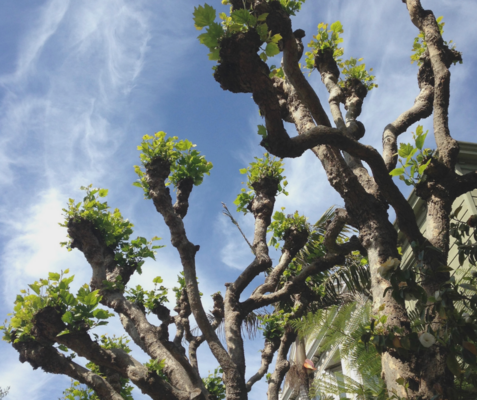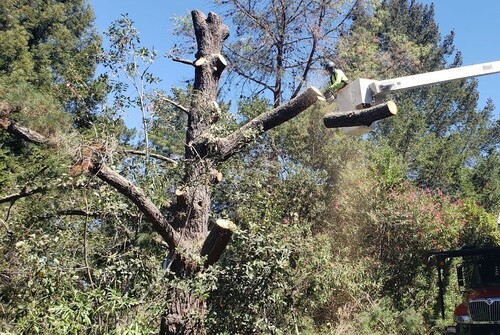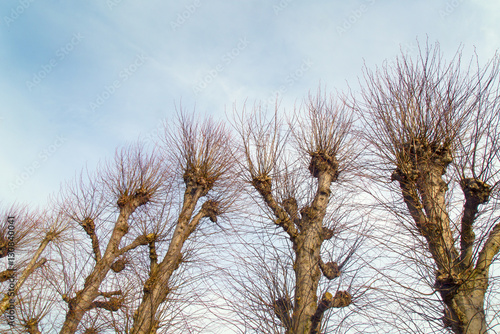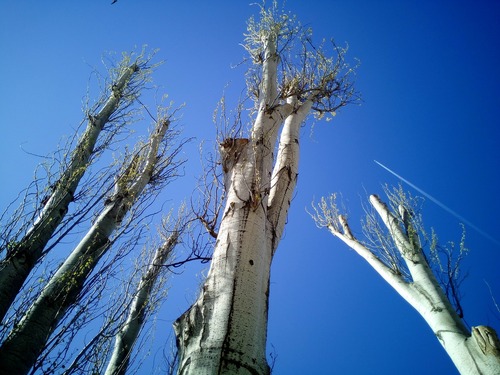Pruning Techniques: Pollarding vs. Topping a Tree

Introduction
Tree pruning is a multifaceted endeavor that blends the art of shaping with the science of tree biology. It's a crucial aspect of arboriculture that serves to maintain a tree's health, aesthetics, and safety. In this extensive guide, we will explore two significant pruning techniques: pollarding and topping. By comprehending their differences, advantages, and the situations where each method is best applied, you can make informed decisions about the care of your trees.
The Merging of Science and Art in Pruning
Pruning requires an understanding of both the science of tree growth and the artistic aspects of shaping trees. It's not simply about removing branches; it involves an in-depth knowledge of a tree's genus or family and the precise application of techniques to ensure the tree's vitality. This includes how it grows, how it is affected by the seasons, and how it responds to pruning. Moreover, every leafed branch that is removed from a tree during pruning translates to less energy production for the tree as a whole. Consequently, every cut made must have a purpose and be executed with accuracy to give the tree the best chance at healing the wound. Let's delve into two of the more drastic pruning methods—pollarding and topping—and their roles in tree care.
What is Topping a Tree?

A Worker Topping a Large Tree
Topping a tree is a pruning method that involves reducing the height of a tree's crown to a specific limit. This can be compared to performing a "heading cut" on the entire tree. A heading cut involves pruning the terminal portion of a branch to a bud or lateral branch that is not large enough to become the dominant growth point. Topping shocks the branch, resulting in one of two potential outcomes: it may stimulate the growth of dormant lateral buds called "watersprouts," or it may kill the branch entirely. Similarly, topping a tree will shock it and can lead to either erratic growth or sudden death. Topping should only be considered in specific situations, such as when a tree has sustained severe storm damage and requires immediate repair.
Why Topping is Discouraged
Topping a tree can have several unfavorable consequences:
- Reduced Energy Production: Topping interferes with a tree's ability to produce energy through photosynthesis. It unbalances the root to crown ratio, disrupting the equilibrium of carbohydrate production and storage. An extensive loss of photosynthetic potential coupled with the rapid depletion of stored energy usually leads to the tree's death.
- Increased Vulnerability to Disease: Removing large portions of a tree's crown typically involves making cuts much too extensive for the tree to heal properly. The tree is unable to compartmentalize the wound, making it susceptible to decay, fungal infections, and infestations by insects, which can ultimately result in its end.
- Watersprout Growth: If a tree survives topping, it typically responds by generating watersprouts. Watersprouts are dormant buds that become activated and grow rapidly and unpredictably, often in a vertical direction. This growth pattern defeats the purpose of the original topping cut and, due to flimsy attachment, poses a risk of branch failure.
Remedies for Topped Trees
If you've observed an abundance of watersprouts after your tree has been topped, there's still hope for recovery. When this happens, there are steps you can take to restructure and balance the tree’s crown. This process is known as "crown restoration." It involves strategically removing watersprouts and any dead branches while promoting well-placed, strongly attached watersprouts to develop into new branches. Crown restoration is a multi-year process that can rejuvenate and reshape your tree's canopy, providing it with a chance to regain health and vitality.
What is Pollarding?

A Line of Trees with Signs of Pollarding
Before delving into the specifics of pollarding, it's crucial to understand that this technique is not suitable for all tree species. Pollarding is primarily applied to large deciduous trees that readily produce new growth after pruning. For pollarding to be effective, it must be initiated when the tree is young.
The Pollarding Process
Pollarding commences with the application of heavy intermodal heading cuts to the tree. This process stimulates the tree to produce numerous watersprouts at the cut sites. These watersprouts are removed annually or every other year. Over time, the pruned areas develop knobs or knuckles, where sprouts continue to originate.
The placement of the cut is very important for this technique to be successful. It is important to cut at the branch collar, taking care to neither leave a stub nor cut into the knuckle.
The timing of these prunings is crucial for the tree's survival. Watersprouts must be removed during the dormant season, typically when the tree sheds its leaves in the fall or winter. Leaves are essential for energy production, and removing sprouts too early can result in the tree's death due to energy depletion and the inability to resprout.
Historical Roots and Modern Use
The technique of pollarding has deep historical roots dating back centuries to Europe. Traditionally, it was used to produce a substantial quantity of small-diameter branches from a consistent source. By cutting branches back year after year and harvesting the long, slender watersprouts, farmers had a reliable source of food for livestock, fuel for fire, and building material for baskets, fences and structures.
In contemporary urban landscapes, pollarded trees are a common sight. The technique is employed to maintain street trees in confined spaces. Rather than allowing a tree to grow to full size, which could interfere with electrical utilities and structures, pollarding can keep a tree healthy at a much smaller and more manageable size.
Distinguishing Pollarding from Topping

Large Birch Trees That Have Been Topped
The most significant distinguishing factor between a pollarded and a topped tree is the formation of knuckles on a pollarded tree. These knuckles act as the source of each year's new growth, ensuring the tree's long-term vitality. Think of these knuckles as large scars on the tree. Each time small-diameter watersprouts are removed, the tree can compartmentalize the wounds and generate new growth from dormant buds in the surrounding tissue the following year. In contrast, topping results in large, unhealable wounds that often lead to the tree's decline.
Consult an Arborist
Whether you have a specific pruning need or are unsure about the appropriate pruning technique for your tree, it's always advisable to consult with a certified arborist. Arborists possess the knowledge and expertise to assess your tree's unique requirements and recommend the most suitable pruning method. Whether you have a topped tree in need of restoration or are considering pollarding for urban landscape management, Arborist Now's skilled professionals can guide you to ensure the optimal health and longevity of your trees.
The Benefits of Proper Pruning
- Healthier Trees: The right pruning technique, whether it's pollarding for large deciduous trees or specialized pruning for tree restoration, contributes to the overall health of your trees.
- Sustainable Resource Production: Historically, pollarding provided a sustainable source of small-diameter branches for various needs, from fuel to crafting.
- Urban Landscape Management: In today's urban environments, proper pruning such as pollarding is vital to maintaining the health and aesthetics of street trees in limited spaces.
- Caring for Your Trees: Trees are valuable assets that provide shade, beauty, and environmental benefits. Regular and informed pruning is a way to ensure they remain healthy and enhance your landscape.
The Environmental Impact
Beyond the health and aesthetics of your trees, proper pruning techniques like pollarding and appropriate restoration pruning have broader environmental benefits.
- Carbon Sequestration: Healthy trees play a critical role in absorbing carbon dioxide from the atmosphere. By ensuring your trees are properly pruned, you're contributing to carbon sequestration efforts.
- Wildlife Habitat: Well-maintained trees provide habitat and food sources for various wildlife species. Proper pruning methods ensure that your trees continue to support local ecosystems.
- Urban Heat Island Effect: In urban environments, trees can potentially help mitigate the urban heat island effect, reducing energy consumption and heat-related stress on city residents. Pruning and managing trees can optimize these benefits.
The Aesthetic Appeal

A Beautiful Public Fountain Surrounded by Pruned Trees
The way a tree is pruned can significantly impact its appearance and the overall aesthetics of your property or the urban environment. Properly pruned trees not only enhance the visual appeal but also complement the architectural and landscape design.
- Enhanced Visual Appeal: A well-pruned tree can be a focal point in your landscape or add to the overall beauty of a street or park. It can also improve curb appeal for residential properties.
- Safety and Access: Pruning can be used to create clear sightlines, prevent branches from obstructing paths or roads, and ensure safe access to buildings and utilities.
- Seasonal Interest: Pruning can also be tailored to enhance a tree's seasonal interest. For instance, shaping a tree to display its beautiful spring blossoms or vibrant fall foliage can be a breathtaking addition to any landscape.
Long-Term Tree Health
Proper pruning techniques are essential for the long-term health of your trees. Whether it's pollarding to maintain urban landscapes, restoration pruning for storm-damaged trees, or seasonal pruning to shape and enhance their appearance, the health of your trees is a top priority.
- Disease Prevention: Regular pruning helps identify and remove diseased or infested branches, preventing the spread of disease to the rest of the tree.
- Structural Integrity: Pruning can help improve a tree's structural integrity, reducing the risk of branch failure during storms or high winds.
- Life Extension: Well-pruned trees tend to live longer and continue to provide their many benefits for extended periods.
Conclusion
Pruning is an intricate blend of science, art, and responsibility. By selecting the right pruning technique, you contribute to the well-being and longevity of your trees while meeting your specific needs. Whether you're addressing storm damage, maintaining an urban landscape, or simply ensuring your trees thrive, consulting with an arborist is the first step toward a healthy and flourishing tree canopy. Your trees deserve the best care, and with the right pruning techniques, they can stand tall and strong for generations to come. Proper pruning not only enhances the aesthetics but also ensures the health, safety, and environmental benefits of your trees, making them invaluable assets to your property and community.
Originally posted on September 10, 2018





